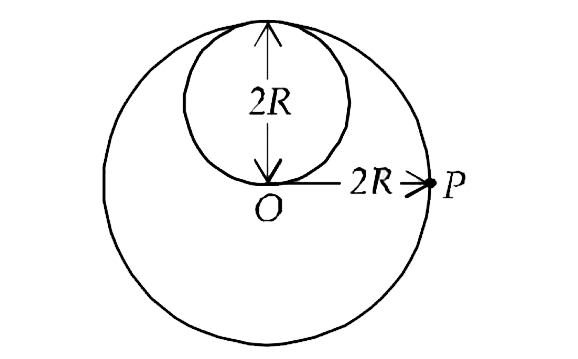the frequency changes by 10 % as the source approaches a stationary observer with constant speed vs. What would be the percentage change in frequency as the sources reaccedes the observer with the same speed ? Given , that vs<<v(v= speed pf sound in air )
14.3%
20%
16.7%
10%
The correct Answer is:D
When the source approaches the observer
f1=f(vv−vs)=f(1−vsv)−=f(1+vsv)
or (f1−ff)×100=vsv×100=10
In the second case, when the source recedes from the observer
f2=f(vv+vs)=f(1+vsv)−=f(1−vsv)
(f2−ff)×100=−vsv×100=−10
In the first case, observed frequency increases by 10% while in the second case, observed frequency decreases by 10%.
Topper's Solved these Questions
- SOUND WAVES AND DOPPLER EFFECTBook:CENGAGE PHYSICS ENGLISHChapter:SOUND WAVES AND DOPPLER EFFECTExercise:Multiple Correct
Explore 44 Videos
- SOUND WAVES AND DOPPLER EFFECTBook:CENGAGE PHYSICS ENGLISHChapter:SOUND WAVES AND DOPPLER EFFECTExercise:Assertion-Reasoning
Explore 24 Videos
- SOUND WAVES AND DOPPLER EFFECTBook:CENGAGE PHYSICS ENGLISHChapter:SOUND WAVES AND DOPPLER EFFECTExercise:Subjective
Explore 56 Videos
- RIGID BODY DYNAMICS 2Book:CENGAGE PHYSICS ENGLISHChapter:RIGID BODY DYNAMICS 2Exercise:Interger
Explore 2 Videos
- SUPERPOSITION AND STANDING WAVESBook:CENGAGE PHYSICS ENGLISHChapter:SUPERPOSITION AND STANDING WAVESExercise:Comprehension Type
Explore 5 Videos
Similar Questions
Which of the following statements are incorrect?
View SolutionStatement I: A tuning fork is considered as a source of an acoustic wave of a single frequency as marked on its body. Statement II: The tuning fork cannot produce any of its harmonics due to its special nature of construction.
View SolutionIn a car race sound signals emitted by two cars are detected by the detector on the straight track at the end point of the race. Frequency observer is 330 Hz and 360 Hz and the original frequency is 300 Hz of both cars. Race ends with the separation of 100 m between the cars. Assume both cars move with constant velocity and velocity of sound is 330ms. Find the time taken by wining car.
View SolutionA lamina is made by removing a small disc of diameter 2R from a bigger disc of uniform mass density and radius 2R, as shown in the figure. The moment of inertia of this lamina about axes passing though O and P is IOandIP respectively. Both these axes are perpendicular to the plane of the lamina. The ratio IPIO is

View SolutionA string of length L, fixed at its both ends is vibrating in its 1st overtone mode. Consider two elements of the string of the same small length at positions l1=0.2Landl2=0.45L from one end.
If K1andK2 are their respective maximum kinetic energies,then
View SolutionThe frequency changes by 10% as the source approaches a stationary observer with constant speed vS, What sould be the percentage change in ferquency as the source recedes from the observer with the same speed? Given that vS<<v (v speed of sound in air).
View SolutionA source of sound is travelling towards a stationary observer. The frequency of sound heard by the observer is 25% more than the actual frequency. If the speed of sound is v, that of the source is
View SolutionWhen both source and observer approach each other with a speed a equal to the half the speed of sound, then determine the percentage change in frequency of sound as detected by the listener.
View SolutionA source of sound emits sound waves at frequency f0. It is moving towards an observer with fixed speed vs(vs<v where v is the speed in air). If the observer were to move towards the source with speed v0 one of the following two graphs (A and B) will give the correct variation of the frequency f heard by the observer as v0 is changed,
_E01_169_Q01.png)
The variation of f with v0 is given correctly by :-
View Solutionthe frequency changes by 10 % as the source approaches a stationary observer with constant speed v_(s) . What would be the percentage change in frequency as the sources reaccedes the observer with the same speed ? Given , that v_(s)lt lt v (v= speed pf sound in air )
View Solutionwhen a source of sound of frequency f crosses stationary observer with a speed v_(s) (lt lt speed of sound v) , the apparent change in frequency Dealtaf is given by
View SolutionA source of sound is approaching an observer with speed of 30 m/s and the observer is approaching the source with a speed 60 m/s. Then the fractional change in the frequency of sound in air (330 m/s) is
View Solutionthe frequency changes by 10 % as the source approaches a stationary observer with constant speed vs. What would be the percentage change in frequency as the sources reaccedes the observer with the same speed ? Given , that vs<<v(v= speed pf sound in air )
View SolutionA siren of frequency n approaches a stationary observer and then receedes from the observer. If the velocity of source (V) lt lt the velocity of sound (C ) , the apparent change in frequency is
View SolutionThe frequency changes by 10% as a sound source approaches a stationary observer with constant speed vs. What would be the percentage change in frequency as the source recedes the observer with the same speed. Given that vs<v (v = speed of sound in air)
View SolutionWhen both the source and the observer are approaching each other with half the speed of sound, find the percentage change observed by the listener in the frequency of sound.
View Solution
